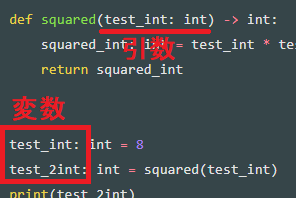変数
変数は値を入れておく箱と思ってください。
test_str: str = "test"
test_int: int = 10
test_strという箱に「test」という文字列が入りました。
test_intという箱に「10」という数値が入りました。
文字列は必ずダブルクォーテーションて囲むことが鉄則です。
型という概念があり、今回だとtest_strは文字型、test_intはint型になります。
その他にもリスト型や辞書型などもありますが、おいおいやります。
リスト型
names: list = ["田中", "鈴木", "田代"]
numbers: list = [1, 3, 100]
辞書型
こちらはリスト型のパワーアップバージョンで、キーとバリューで成り立っています。
# "キー": "バリュー"
test_dict: dict = { "田中": 76, "鈴木": 80, "田代": 30 }
上記は、キーが名前でバリューが点数という例です。
if文
もし~だったら~
そのままですね。
test_str: str = "test"
if test_str == "test":
print("同じ")
else:
print("違う")
もしtest_strと"test"が等しければ「同じ」と表示する。
でなければ、「違う」と表示する。
test_int = 10
if test_int == 10:
print("test_intは10(等しい)")
elif test_int <= 10:
print("test_intは10以下")
elif test_int >= 10:
print("test_intは10以上")
test_intが10と等しければ「test_intは10(等しい)」と表示。
test_intが10以下なら「test_intは10以下」と表示。
test_intは10以上なら「test_intは10以上」と表示。
インデントに注意しましょう!
if test_int == 10:
print("test_intは10(等しい)")
この場合だとprint文はifの中に入っていません。(ネストされていない)
処理が別々になります。
if文の中の処理はなく、print文は必ず表示される状態になってしまっています。
for文(繰り返し処理)
for count in range(5):
print(count)
こちらは5回繰り返し処理が走ります。
countの中身は0~4までカウントアップされます。
実行結果はこちらになります。
0
1
2
3
4
リスト型をfor文で回す
heroes: list = ["アンパンマン", "さいたま", "キング", "ジェノス"]
for hero in heroes:
print(hero)
heroesの中身を順にheroに代入して回します。
実行結果はこちらになります。
アンパンマン
さいたま
キング
ジェノス
関数
def show_heroes(heroes: list) -> None:
for hero in heroes:
print(hero)
heroes: list = ["アンパンマン", "さいたま", "キング", "ジェノス"]
show_heroes(heroes)
def show_heroes(heroes: list) -> None:こちらが関数になります。
一番下のshow_heroes(heroes)がshow_heroes関数を呼び出しています。
()の中のheroesを引数と言います。
heroesをshow_heroes関数に渡しています。
-> Noneについては返り値がないという意味です。
返り値については次で説明します。
返り値
def squared(test_int: int) -> int:
squared_int: int = test_int * test_int
return squared_int
test_int: int = 8
test_2int: int = squared(test_int)
print(test_2int)
こちらはtest_intに8を代入して、squared関数で2乗した値を返してtest_2intに代入しています。
return squared_intでsquared_intの値を返すという意味です。
int型を返しているので-> intとしています。
アノテーション
アノテーションとは、変数代入のときの、
test_int: int = 8
:intの部分になります。
あと、先程の
def squared(test_int: int) -> int:
の-> intの部分になります。
本当はこれがなくてもプログラム上では動きます。
なぜアノテーションをつけるかというと、変数ではすぐなんの型かがわかりあとあと、メンテナンス性がいいからです。
def squared(test_int: int) -> int:
こちらも関数の中身を全部見なくても引数がint型が渡ってきていて、返り値がint型であることが一行だけみればわかります。
def squared(test):
アノテーションがない場合、testの中身はなんなのか関数の中処理を見ないとわからないし、返り値の型又は返り値があるかないかなど全くわかりません。
これじゃあ、あとあと修正するときが大変ですよね?
ということでアノテーションはつけましょう!というお話です。
